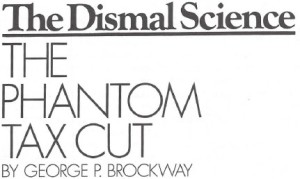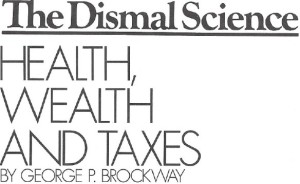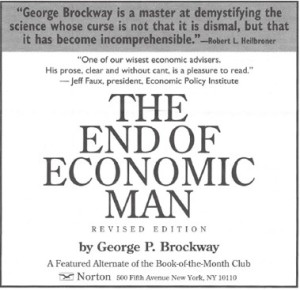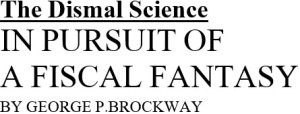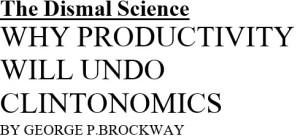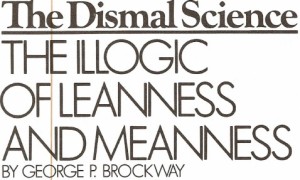By George P. Brockway, originally published September 22, 1997
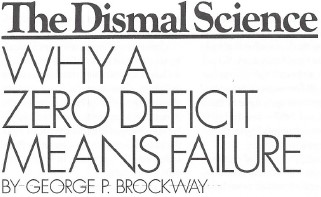 I DON’T want to alarm anyone, but I think it important for us to realize that the United States of America is about to sail into unfamiliar waters. What is more, those waters are inaccurately charted.
I DON’T want to alarm anyone, but I think it important for us to realize that the United States of America is about to sail into unfamiliar waters. What is more, those waters are inaccurately charted.
Many years ago I had occasion to consult charts of the Aegean Sea, the island pocked body of water between Greece and Asia Minor. From 1522 to 1912 the principal southern islands were occupied by the Ottoman Turks, and from 1912 to 1947 by Italy. I used British revisions of charts originally prepared by the Italian Navy. Scores of tiny islands and mid sea rock formations had notations beside them: “Reported 2.6 mi. north, 1949,” or “Reported 1.9 mi. south, 1948.”
The economic waters we are now entering are at least as badly charted. The years 1947, 1948, 1949, 1951, 1956, 1957, 1960, and 1969 are the only ones since the great Crash of 1929 in which we managed to balance the Federal budget. As we shall see, what happened in those eight years is the diametrical opposite of what is generally assumed, and our misconception is driving us in an unexpected and unhappy direction.
We need to understand this because we are approaching another balanced budget much faster than anyone thought possible. Indeed, the embarrassing fact is that tax revenues are so good in today’s relatively affluent society that the budget would balance itself in a couple of years if Congress just sat on its hands and watched[1].
The universal mantra has been that we must at any cost balance the budget by 2002. We came within two votes of .launching a Constitutional amendment to that effect. I suppose most people have forgotten the reasoning behind the mantra. Forgetfulness, of course, is what mantras, like the Big Lie, are for. No matter.
The various reasons that were given for balancing the budget a couple of years ago appear to have been reduced to one: President Clinton, House Speaker Newt Gingrich and all their economic advisers say that the balancing will lower the interest rate and hence save good citizens money as well as make for prosperity.
Yes, but I seem to remember that six months ago-on March 25, 1997, to be precise-the Federal Reserve Board kicked the Federal funds rate up a quarter of a point, and soon thereafter every other interest rate went up at least that much. What was the budget news then? There was certainly a noisy squabble going on, but was there anyone, inside the Beltway or out, who was proposing to increase the deficit? If no one was even thinking about such a thing, why did the interest rate go up?
We don’t have to reach back as far as March 25 for incongruities. In the midst of the budgeteers’ recent self-congratulations, the Bureau of Labor Statistics of the Department of Labor announced that the official unemployment rate had fallen to 4.8 per cent (it’s since crept up a tenth of a point or two). That prompted a flood of professional prophecies that the Federal Reserve Board would have to (the Board seems never to act of its own free will) raise the interest rate again to keep more people from getting jobs.
And shortly thereafter the International Monetary Fund, well-known for its conventional views, cautioned that “undue delay in tightening monetary policy could undermine the current expansion.”
Look at the crosscurrents we have drifted into:
- News about an imminent budget balance, which is supposed to presage prosperity.
- News about falling unemployment, which you might think would be an essential element of prosperit
- Prophecies about necessarily rising interest rates, which must be bad if it’s good to balance the budget to get lower rates.
While we were being buffeted by these currents, Federal Reserve Chairman Alan Greenspan made his semiannual reports to Congress, partly televised on C-Span.
I always look forward to the televised versions of these reports, because they often include questions by Congressmen and answers by the Chairman. The Times and the Wall Street Journal usually provide little more than a summary of the Chairman’s prepared remarks. Constant readers may remember my excitement two years ago (“What Greenspan Really Told Congress,” NL, July 17-31, 1995), when I scooped the world with the news that Greenspan doesn’t believe in NAIRU (or a natural rate of unemployment), that he doesn’t think we must have high interest rates in order to sell our bonds, and that he does think the increasing inequality of incomes is the most serious economic problem now facing the United States.
No doubt chagrined by my scooping them, the rest of the media have not noticed my reportage (though I have a videotape of Greenspan’s words). Neither were they moved to fully report Greenspan’s latest testimony, although in the course of it he had a wary yet respectful exchange with Congressman Jesse L. Jackson Jr. of Illinois.
Jackson questioned the wisdom of relying on the official unemployment figures, since they count as unemployed only people who looked for work last week. A better number, Jackson suggested, would include those too discouraged to continue looking for work, those too turned off ever to have looked for lawful work, those working part time when they would rather work full time, and those slogging away at jobs for which they are overqualified. If all these people were counted, Jackson said, unemployment would be nearer 20 million than the officially reported 6 million or 7 million.
 Greenspan replied that he did not know enough about the people Jackson mentioned to use them as a basis for policy, but he acknowledged that they exist. His acknowledgment is my scoop for this week. For I submit that an economy incapable of providing proper jobs for 15 or 20 per cent of its work force is not an adequate economy. It may be “prosperous,” but it does not come close to doing what an economy ought to do. So we have a fourth crosscurrent to reckon with as we approach the waters whose charts are questionable.
Greenspan replied that he did not know enough about the people Jackson mentioned to use them as a basis for policy, but he acknowledged that they exist. His acknowledgment is my scoop for this week. For I submit that an economy incapable of providing proper jobs for 15 or 20 per cent of its work force is not an adequate economy. It may be “prosperous,” but it does not come close to doing what an economy ought to do. So we have a fourth crosscurrent to reckon with as we approach the waters whose charts are questionable.
PRESIDENT CLINTON and Speaker Gingrich and practically the entire economics profession, as I have said, are united in steering us toward a balanced budget on the theory that this will reward us with lower interest rates. A look at the records, however, reveals that in every one of the eight post-Depression years with a balanced Federal budget the prime interest rate (to which most rates we pay are related) went up, not down. We must conclude, therefore, that either our leaders or the records (or both) have lost their bearings. Clinton, for instance, claims credit for reducing the Federal deficit and says it has resulted in lower interest rates. Granted, recent budgets have boasted a reduced deficit. The Republicans, not surprisingly, insist they brought about the reductions, but that’s not what is plainly wrong with the President’s story.
What’s wrong is that although the deficit has gone down in all five years of his watch, the interest rate went up in three of them -1994, 1995 and 1997-and the prime rate is now two full points higher than it was when Clinton took office.
In other words, five years of reinventing government-of “it’s the economy, stupid”; of the end of welfare as we know it; of the end of the era of big government-have brought forth, not a decrease, but an increase of 32 per cent in the prime interest rate. The emperor, his advisers and his loyal opposition may have plenty of new clothes; they just have them on inside out and backward. There is no empirical evidence whatever that a falling deficit causes or inspires or favors or even accompanies lower interest rates.
Nor is there evidence for a contrary causation: A high deficit has not automatically produced high interest rates. Consider the famous years 1981 through 1986, when Ronald Reagan was President and Paul A. Volcker was the Federal Reserve Board Chairman. The prime interest rate fell from 21.5 per cent to 7.5 per cent. Was this the result of a falling budget deficit? Hardly. The deficit more than tripled in those years, and the interest rate went down at an equally record breaking pace.
Conventional economics, incidentally, teaches that high deficits cause high inflation, and that high interest rates cure inflation. Consequently, true believers should expect that inflation soared in the Reagan- Volcker years. Again the records belie conventional expectations. In 1981 the annual change in the Consumer Price Index was 10.3 per cent. In 1986 it was only 1.9 per cent.
In short, the economic waters we are now entering are charted to correlate high deficits with high interest rates and low inflation. A realistic mapping, though, shows that low or nonexistent deficits are not associated with falling interest rates, while high interest rates are commonly associated with high inflation.
The discrepancies between the conventional view of the economy and its recent performance lead me to suggest the future may prove Proust was right in observing that our desires may be fulfilled on condition that they do not bring the happiness we expect of them. We may succeed in balancing the budget, but it is exceedingly unlikely that the interest rate will fall as far as our leaders and advisers expect. Even if the rate should drop a point or two, it is unlikely that business will correspondingly expand. If anything, a balanced budget will act as a constraint on business, in the same way that the drive for a balanced budget has constrained expenditures for maintaining our infrastructure, for improving the lot of the disadvantaged among us, and for nurturing progress in the arts and sciences.
Is there no limit to the deficit that we can sustain? Sure there is a limit. My father advised my wife and me always to stretch a little when buying a home for our family. That way we could, and did, steadily improve our standard of living. Naturally, we had to be able to pay the interest on our successive mortgages. It is the same with a capitalist nation. Capitalism is based on borrowing as much as it can from the future in order to build for the future.
A zero deficit is a confession of a failure of faith in the future, especially when 20 million citizens lack proper jobs.
The New Leader
[1] As it happened, over the four years following the publishing of this article the Clinton Administration balanced the Federal Budget four years running: http://www.factcheck.org/2008/02/the-budget-and-deficit-under-clinton/
